engine CHEVROLET ASTRO 1998 2.G User Guide
[x] Cancel search | Manufacturer: CHEVROLET, Model Year: 1998, Model line: ASTRO, Model: CHEVROLET ASTRO 1998 2.GPages: 414, PDF Size: 21.46 MB
Page 11 of 414
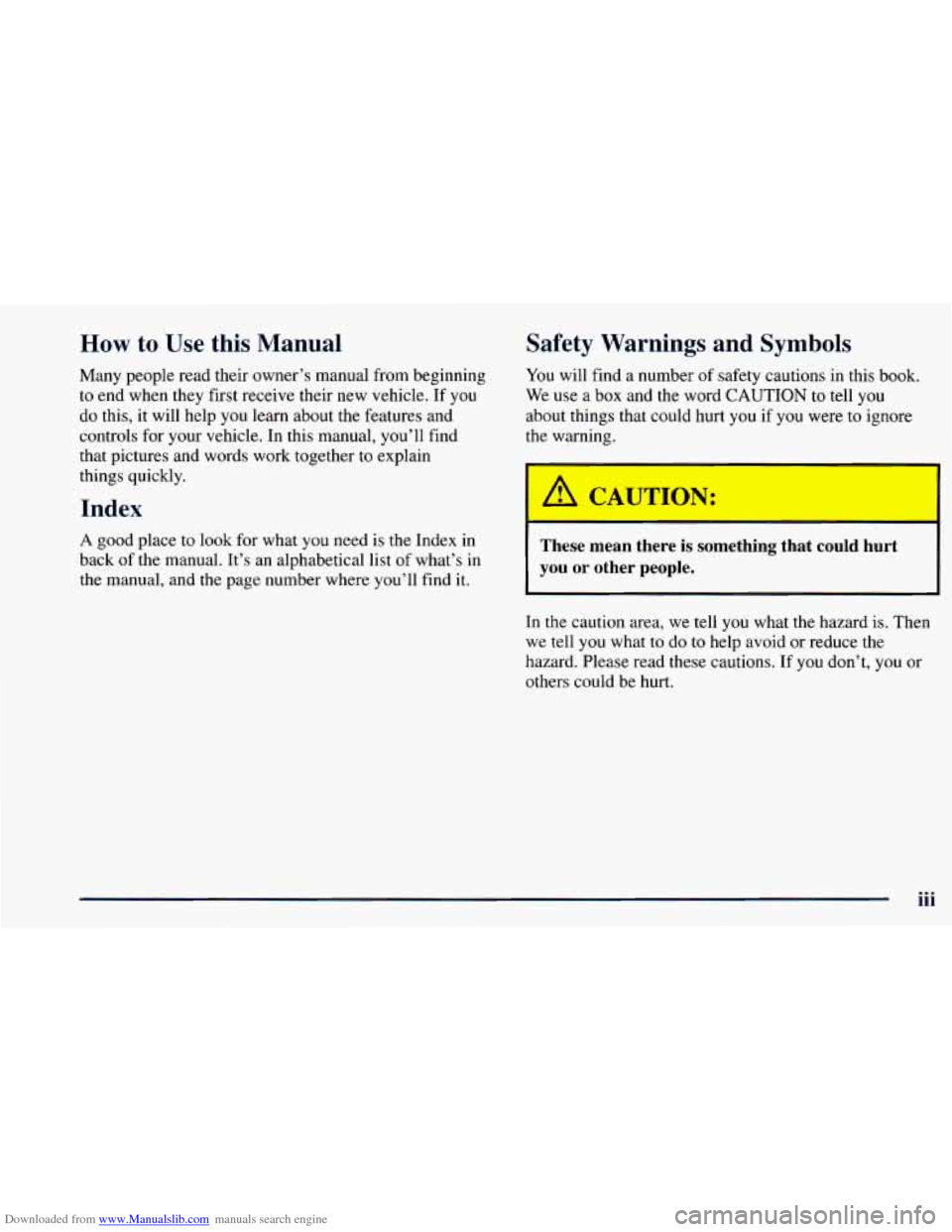
Downloaded from www.Manualslib.com manuals search engine How to Use this Manual
Many people read their owner’s manual from beginning
to end when they first receive their new vehicle. If you
do this, it will help you learn about the features and
controls for your vehicle. In this manual, you’ll find
that pictures and words work together to explain
things quickly.
Index
A good place to look for what you need is the Index in
back of
the manual. It’s an alphabetical list of what’s in
the manual, and the page number where you’ll find it.
Safety Warnings and Symbols
You will find a number of safety cautions in this book.
We use a
box and the word CAUTION to tell you
about things that could hurt you if you were to ignore
the warning.
A CAUTION: I
These mean there is something that could hurt
you or other people.
In the caution area, we tell you what the hazard is. Then
we tell you what to do to help avoid or reduce the
hazard. Please read these cautions. If you don’t, you or
others could be
hurt.
iii
Page 12 of 414
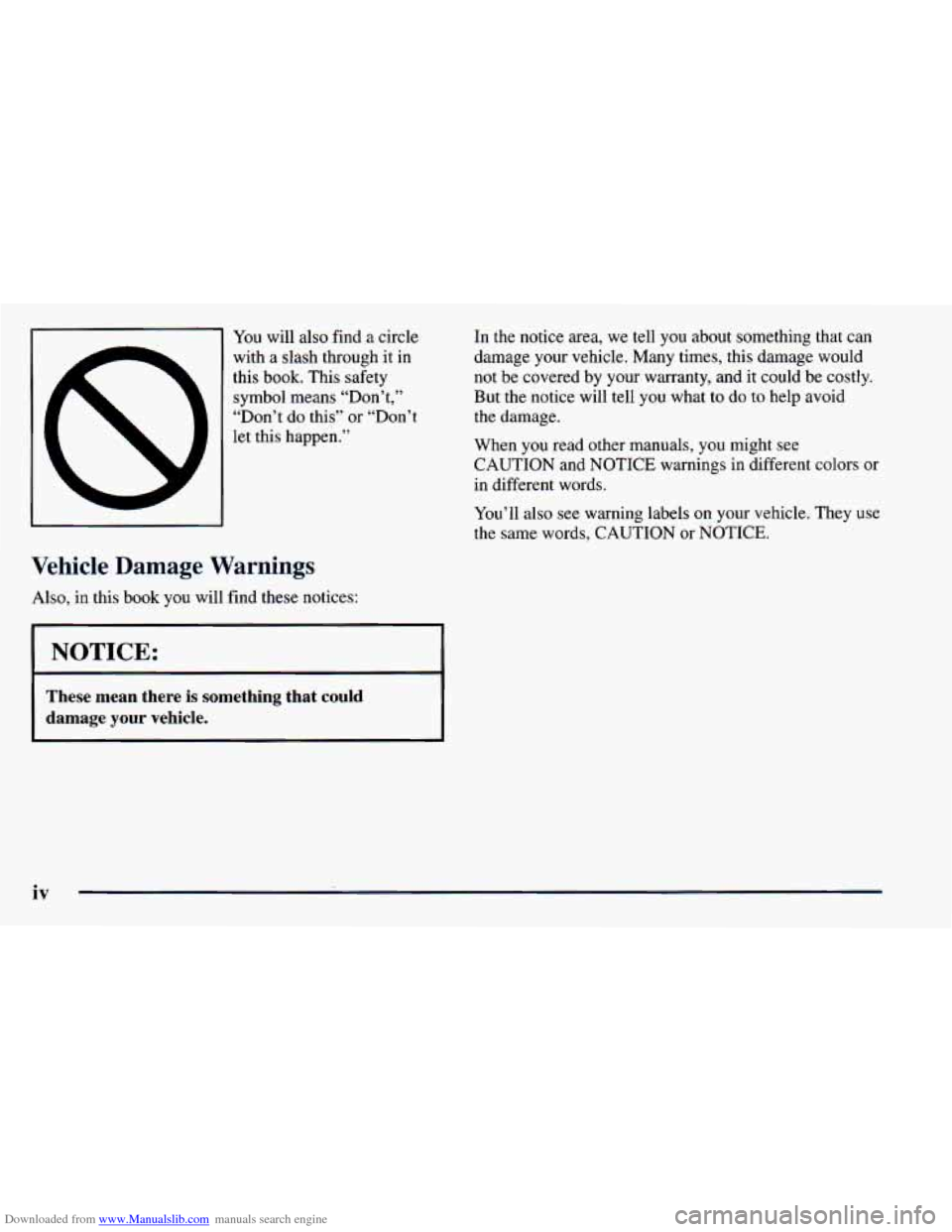
Downloaded from www.Manualslib.com manuals search engine You will also find a circle
with a slash through it in
this book. This safety
symbol means “Don’t,’’
“Don’t do this” or “Don’t
let this happen.”
Vehicle Damage Warnings
Also, in this book you will find these notices:
NOTICE:
In the notice area, we tell you about something that can
damage your vehicle. Many times, this damage would
not be covered by your warranty, and it could be costly.
But the notice will tell you what to do to help avoid
the damage.
When you read other manuals, you might see
CAUTION and NOTICE warnings in different colors or
in different words.
You’ll also see warning labels on your vehicle. They use
the same words, CAUTION or NOTICE.
These mean there is something that could
damage your vehicle.
iv
Page 13 of 414
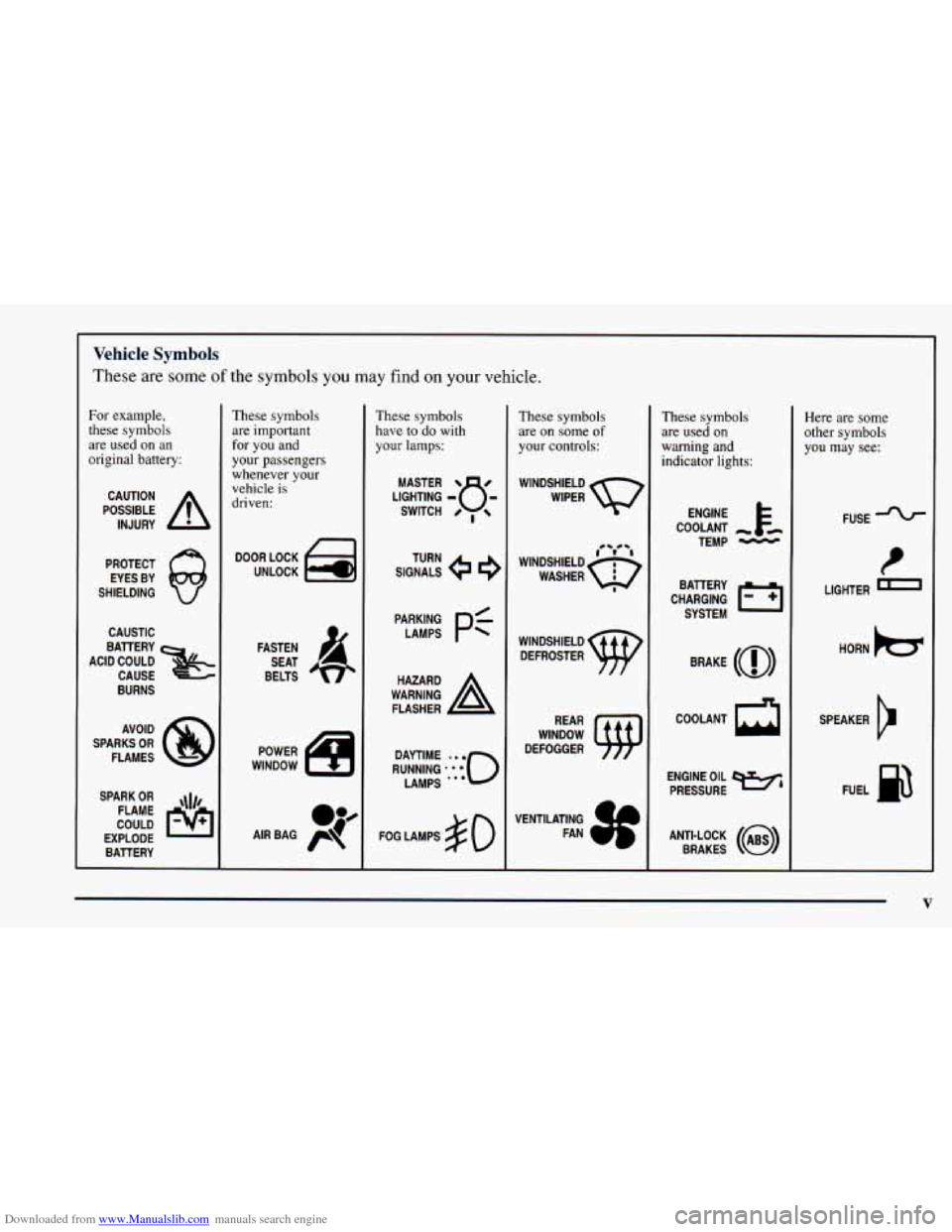
Downloaded from www.Manualslib.com manuals search engine Vehicle Symbols
These are some of the symbols you may find on your vehicle.
For example,
these symbols
are used on an
original battery:
POSSIBLE A
CAUTION
INJURY
PROTECT EYES BY
SHIELDING
CAUSTIC
BURNS
AVOID
SPARKS
OR
FLAMES
SPARK
OR ,\I/,
COULD FLAME
EXPLODE BATTERY
These symbols
are important
for you and
your passengers
whenever your
vehicle
is
driven:
DOOR LOCK
UNLOCK
FASTEN SEAT
BELTS
POWER
WINDOW
These symbols have to do with
your lamps:
SIGNALS e
TURN
FOG LAMPS
$0
These symbols
are on some
of
your controls:
WINDSHIELD
DEFROSTER
WINDOW
DEFOGGER
VENTILATING FAN
These symbols are used on
warning and
indicator lights:
COOLANT
TEMP
-
CHARGING I-1
BATTERY
SYSTEM
BRAKE
(a)
COOLANT a
ENGINE OIL e,
PRESSURE
ANTI-LOCK
(@)
BRAKES
Here are some
other symbols
you may see:
FUSE -%-
t
LIGHTER
HORN
b
SPEAKER
b
FUEL p3
V
Page 14 of 414
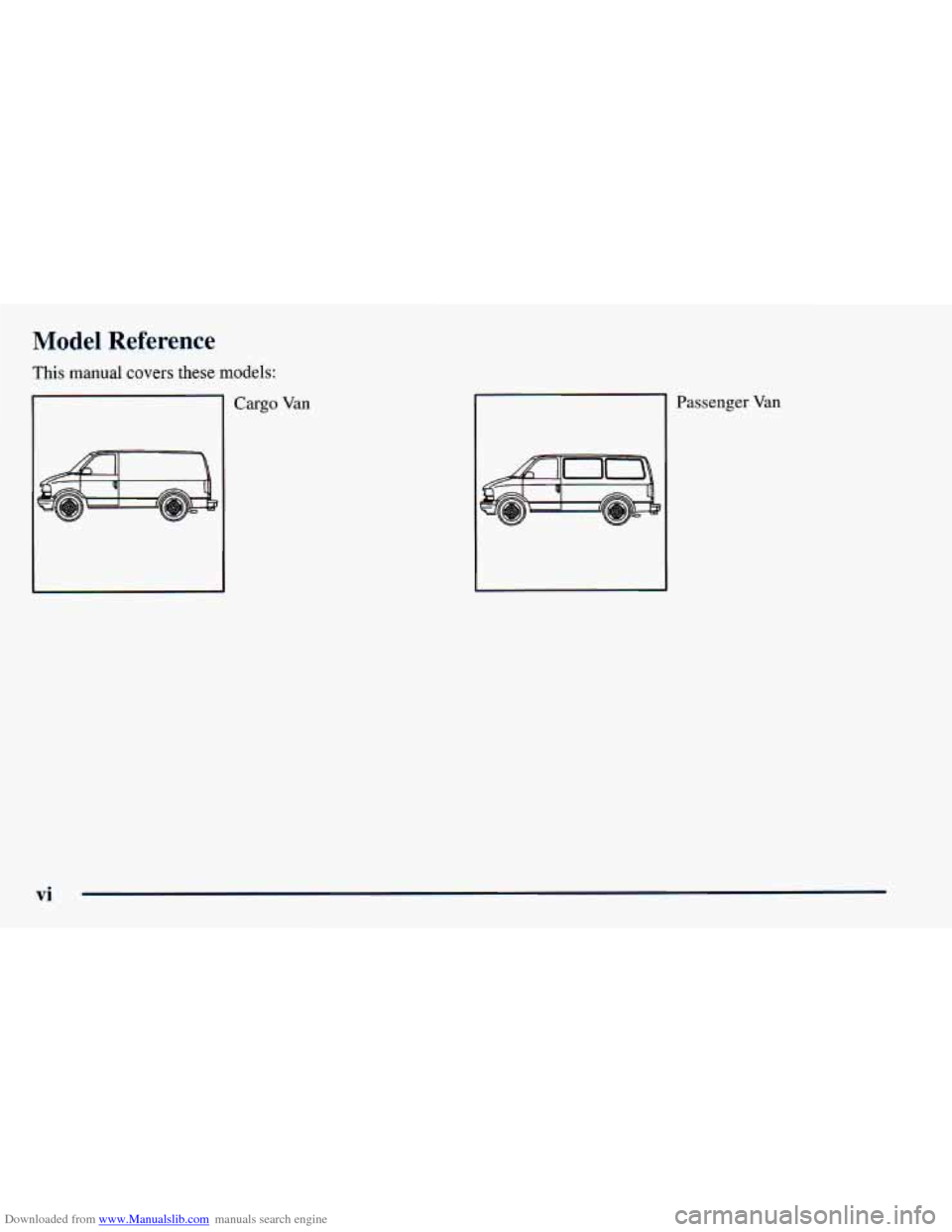
Downloaded from www.Manualslib.com manuals search engine Model Reference
This manual covers these models:
Cargo Van Passenger Van
vi
Page 15 of 414
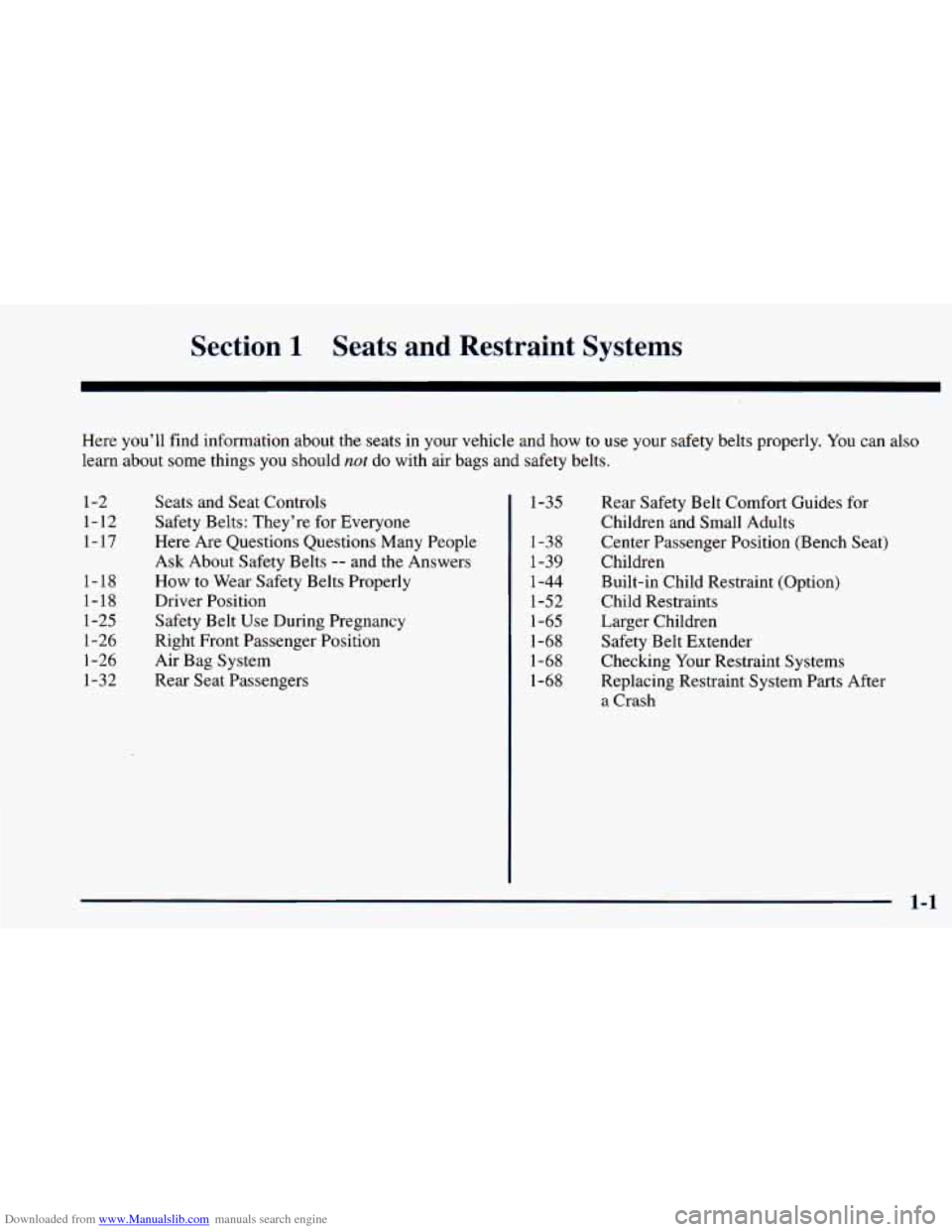
Downloaded from www.Manualslib.com manuals search engine Section 1 Seats and Restraint Systems
Here you’ll find information about the seats in your vehicle and how to use your safety belts properly. You can also
learn about some things you should
not do with air bags and safety belts.
1-2
1-12 1-17
1-18
1-18 1-25
1-26
1-26
1-32 Seats
and Seat Controls
Safety Belts: They’re for Everyone
Here Are Questions Questions Many People
Ask About Safety Belts
-- and the Answers
How to Wear Safety Belts Properly
Driver Position
Safety Belt Use During Pregnancy
Right Front Passenger Position
Air Bag System
Rear Seat Passengers 1-35
1-38 1-39
1-44
1-52
1-65
1-68
1-68
1-68 Rear
Safety Belt Comfort Guides for
Children and Small Adults
Center Passenger Position (Bench Seat)
Children
Built-in Child Restraint (Option)
Child Restraints
Larger Children
Safety Belt Extender
Checking Your Restraint Systems
Replacing Restraint System Parts After
a Crash
Page 16 of 414
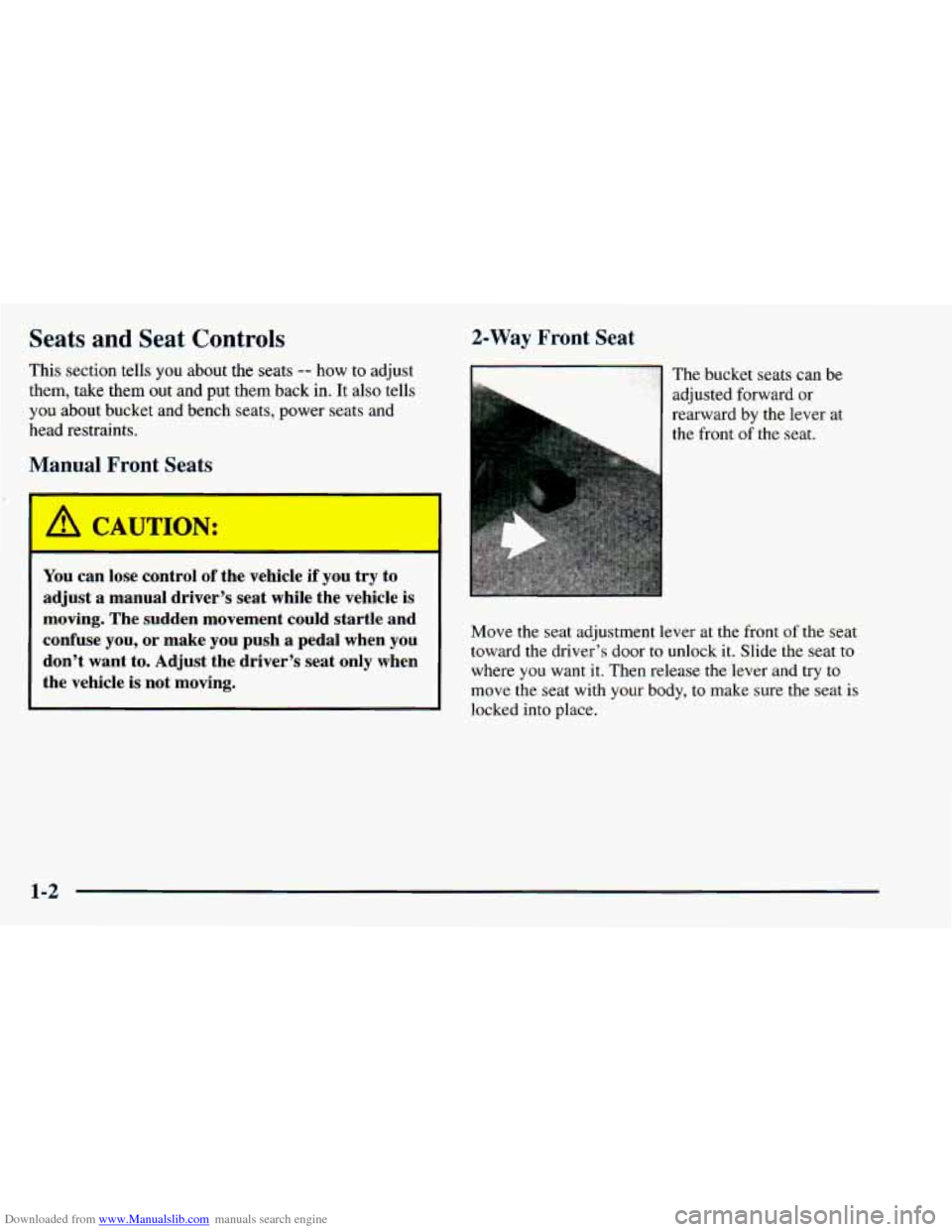
Downloaded from www.Manualslib.com manuals search engine Seats and Seat Controls
This section tells you about the seats -- how to adjust
them, take them out and put them back in. It also tells
you about bucket and bench seats, power seats and
head restraints.
Man1 7 Front Sc ts
2-Way Front Seat
You can lose control of the vehicle if you try to
adjust a manual driver’s seat while the vehicle
is
moving. The sudden movement could startle and
confuse you, or make you push a pedal when you
don’t want to. Adjust the driver’s seat only when
the vehicle
is not moving.
’ . ’ . ’? .. The bucket seats can be
adjusted forward or
rearward
by the lever at
the front
of the seat.
Move the seat adjustment lever at the front
of the seat
toward
the driver’s door to unlock it. Slide the seat to
where you want it. Then release the lever and try to
move the seat with your body, to make sure the seat
is
locked into place.
1-2
Page 17 of 414
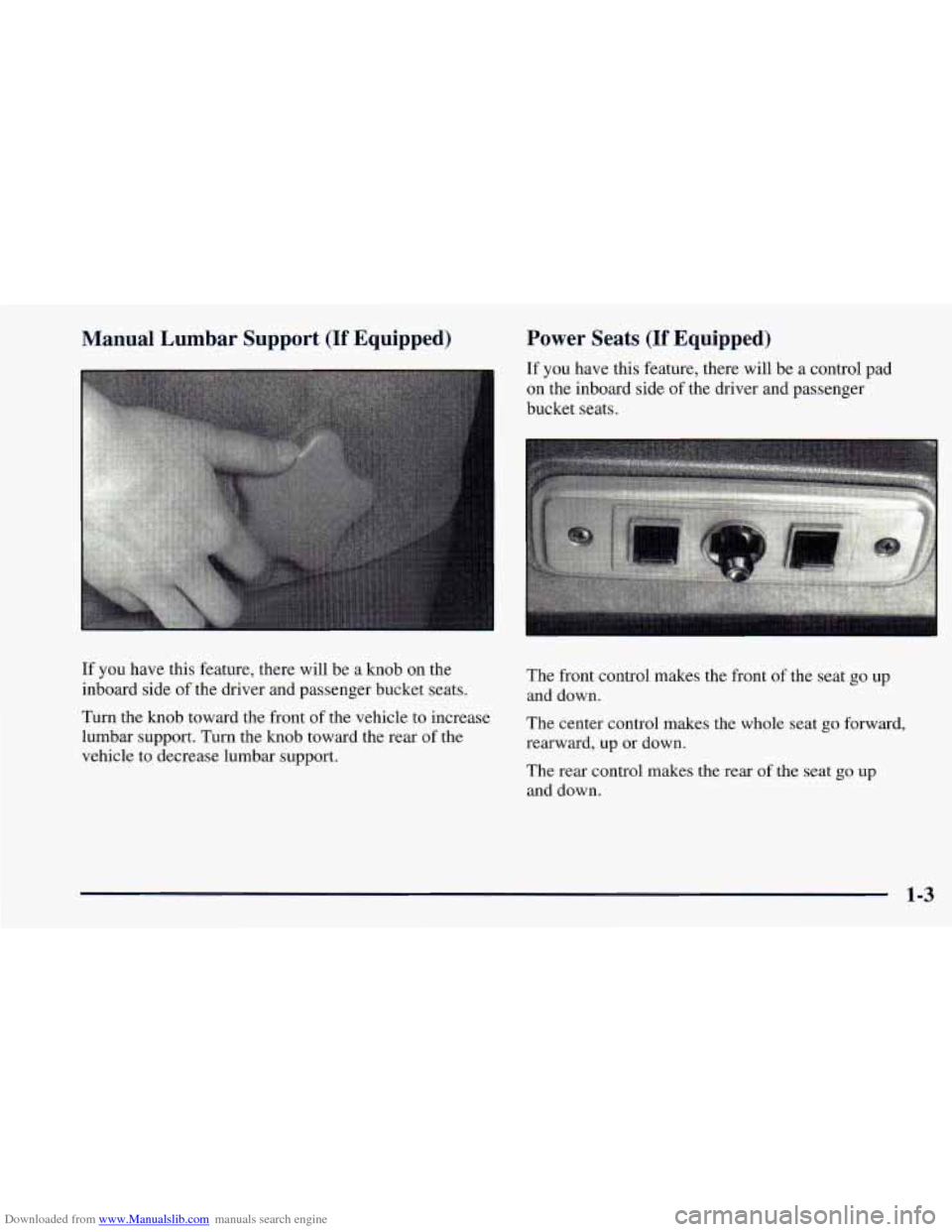
Downloaded from www.Manualslib.com manuals search engine Manual Lumbar Support (If Equipped) Power Seats (If Equipped)
If you
have this feature, there will be a control pad
on the inboard side
of the driver and passenger
bucket seats.
If you have this feature, there will be a knob on the
inboard side of the driver and passenger bucket seats.
Turn the knob toward the front
of the vehicle to increase
lumbar support. Turn the knob toward the rear of the
vehicle
to decrease lumbar support. The
front control makes the front of the seat go up
and down.
The center control makes the whole seat go forward,
rearward, up or down.
The rear control makes the rear
of the seat go up
and down.
1-3
Page 18 of 414
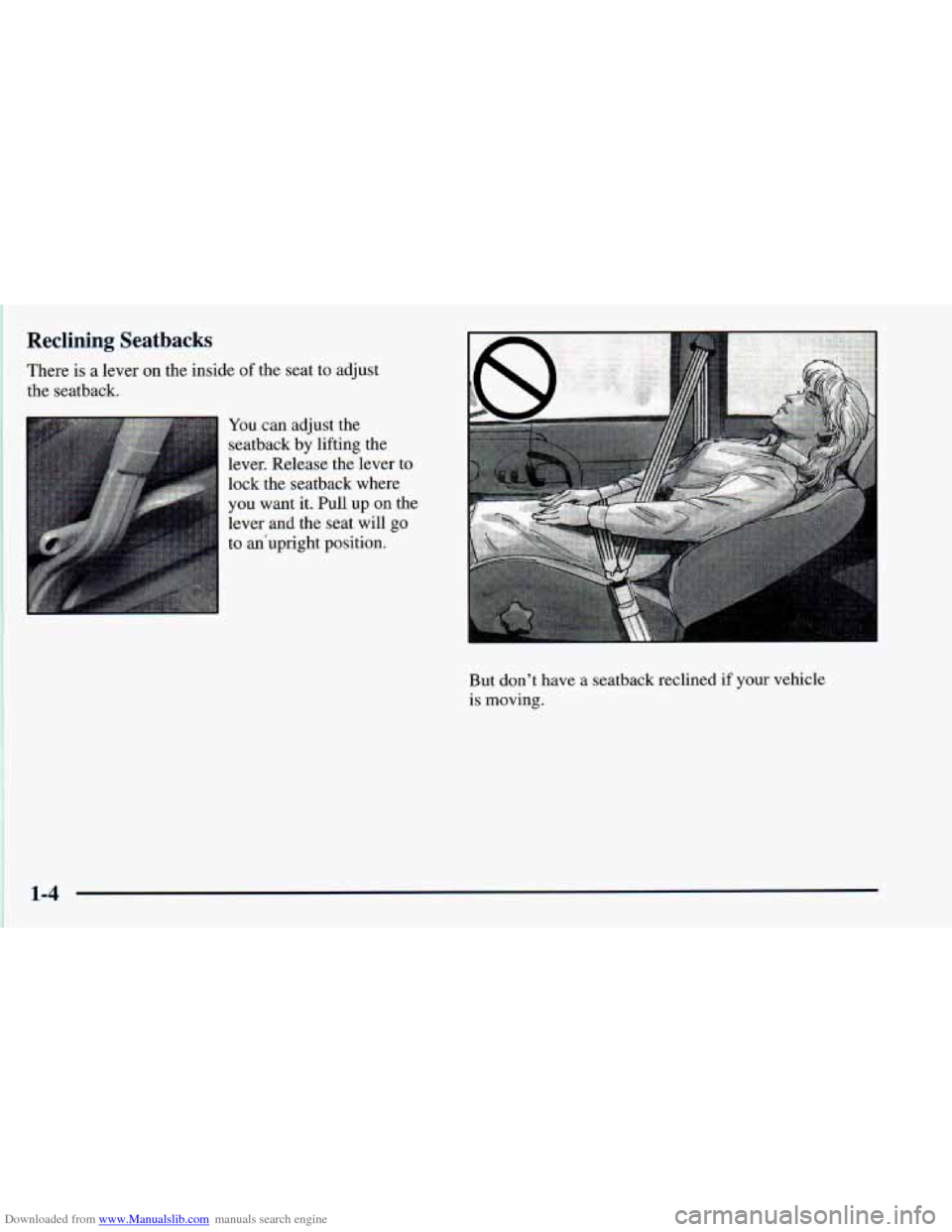
Downloaded from www.Manualslib.com manuals search engine Reclining Seatbacks
There is a lever on the inside of the seat to adjust
the seatback.
You can adjust the
seatback
by lifting the
lever. Release the lever to
lock the seatback where
you want it. Pull up on the
lever and the seat will go
to an'upright position.
But don't have a seatback reclined if your vehicle
is moving.
Page 19 of 414
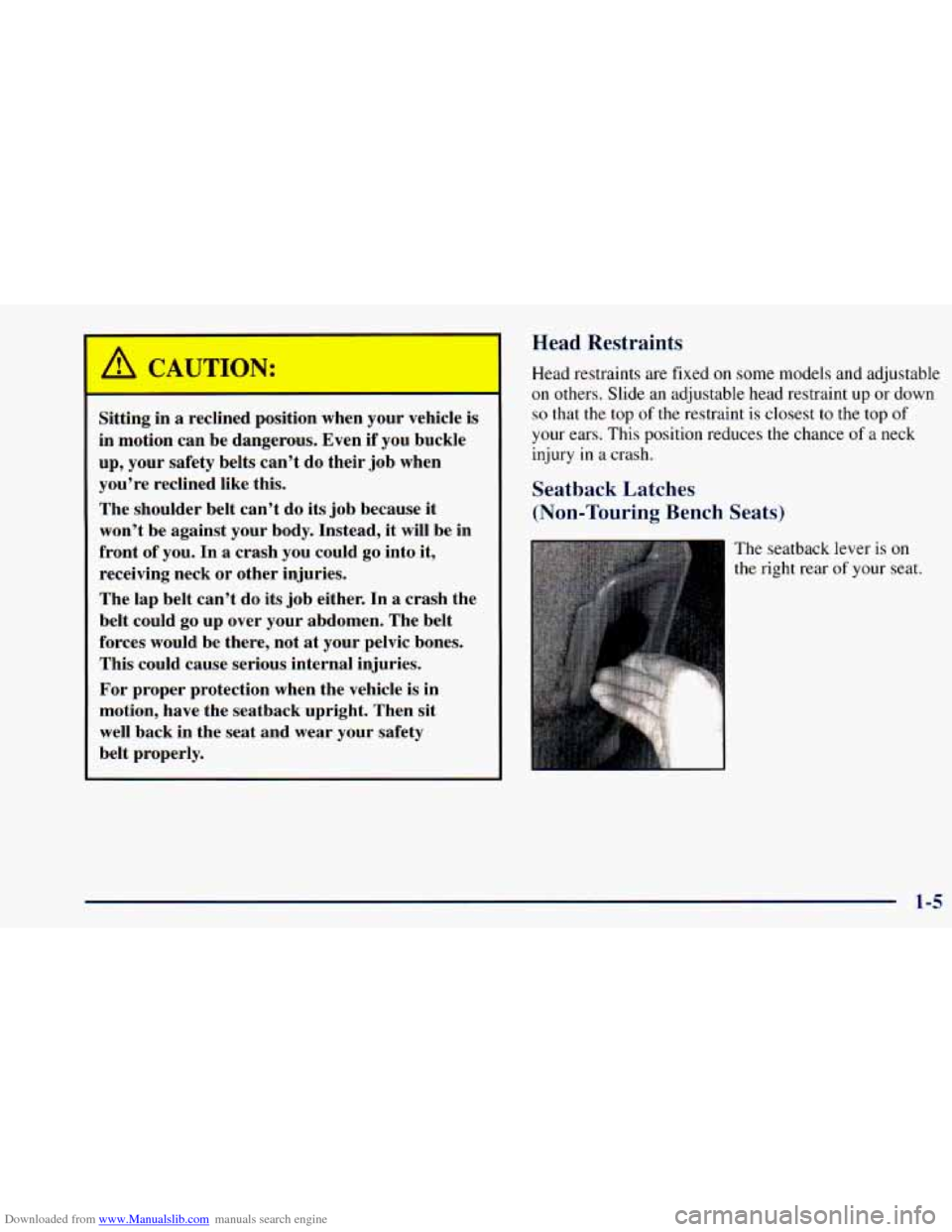
Downloaded from www.Manualslib.com manuals search engine A CAUTION:
--
Sit ---lg in a reclined position wl- - n your vehicle is
in motion can be dangerous. Even if you buckle
up, your safety belts can’t do their job when
you’re reclined like this.
The shoulder belt can’t do its job because
it
won’t be against your body. Instead, it will be in
front of you. In a crash you could go into it,
receiving neck or other injuries.
The lap belt can’t do its job either. In
a crash the
belt could go
up over your abdomen. The belt
forces would be there, not at your pelvic bones.
This could cause serious internal injuries.
For proper protection when the vehicle is in
motion, have the seatback upright. Then sit well back in the seat and wear your safety
belt properly.
Head Restraints
Head restraints are fixed on some models and adjustable
on others. Slide an adjustable head restraint
up or down
so that the top of the restraint is closest to the top of
your ears. This position reduces the chance of a neck
injury
in a crash.
Seatback Latches
(Non-Touring Bench Seats)
The seatback lever is on
the right rear of your seat.
1-5
Page 20 of 414
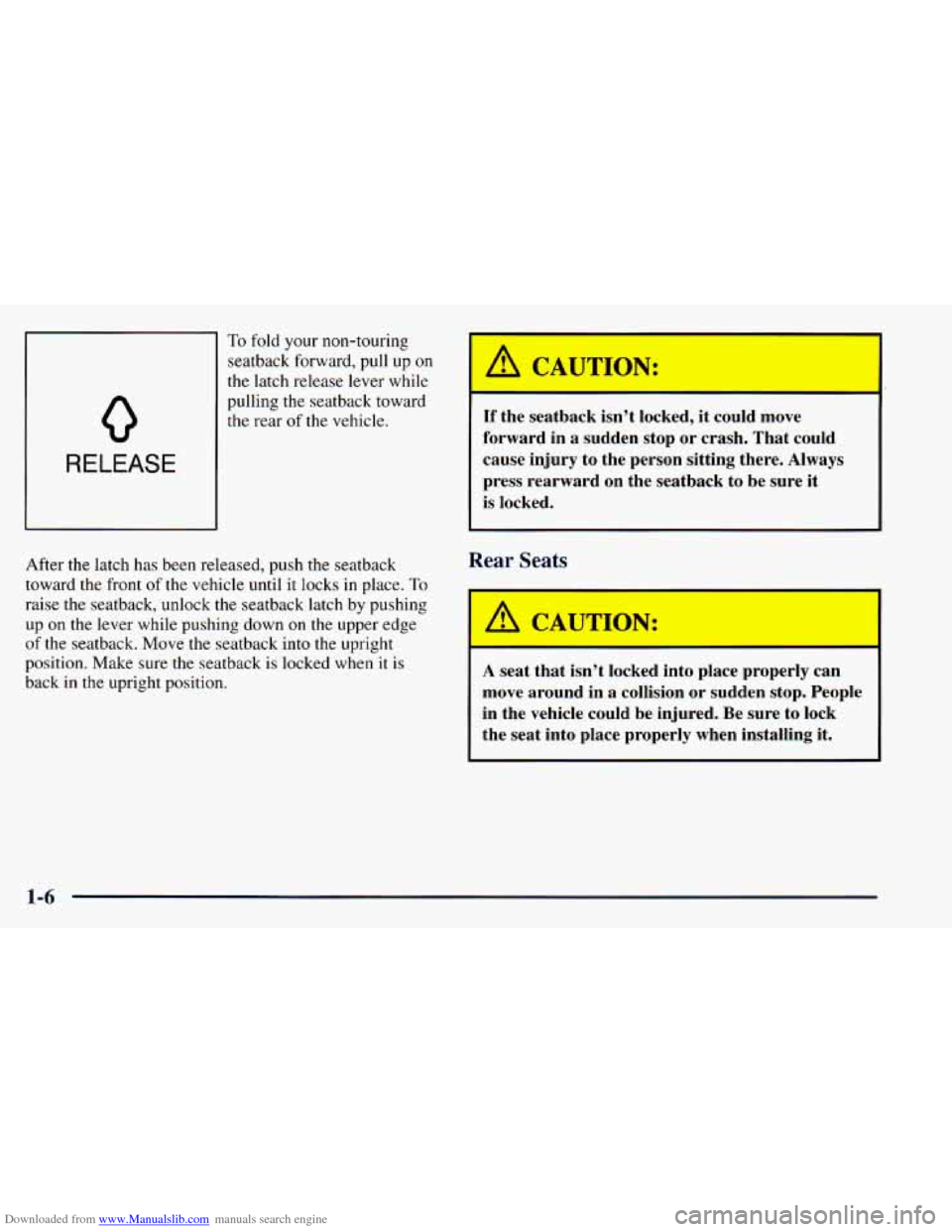
Downloaded from www.Manualslib.com manuals search engine 0
RELEASE
To fold your non-touring
seatback forward, pull up on
the latch release lever while
pulling the seatback toward
the rear
of the vehicle.
After the latch has been released, push the seatback
toward the front of the vehicle until it locks in place.
To
raise the seatback, unlock the seatback latch by pushing
up
on the lever while pushing down on the upper edge
of the seatback. Move the seatback into the upright
position. Make sure the seatback is locked when it is
back
in the upright position.
A CAUTION:
If the seatback isn’t locked, it could move
forward in a sudden stop or crash. That could
cause injury to the person sitting there, Always
press rearward on the seatback to be sure it
is locked.
Rear Seats
I
A seat that isn’t locked into place properly can
move around in a collision or sudden stop. People
in the vehicle could be injured. Be sure to lock
the seat into place properly when installing it.
1-6